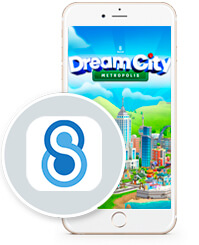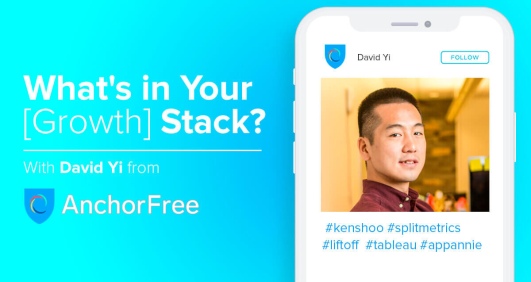Q&A with David
Based in the San Francisco Bay Area, David Yi was formerly User Acquisition Manager at leading mobile game network Storm8, where his team manages global UA and monetization campaigns for their portfolio of 45+ games. Prior to pursuing a career in mobile marketing, David worked as a Financial Analyst.
Read David's latest article: "What’s in Your [Growth] Stack? David Yi, AnchorFree"
What does it take to succeed in mobile marketing?
Being able to adapt is critical to success in our industry. The mobile market, technology, and your product can change so quickly and drastically that you need to be able to keep up and adjust your marketing efforts accordingly.
What do you think are the main differences between marketing a gaming app vs a non-gaming app?
Gaming remains to be one of the top 5 activities on smartphones today. A good game can have users spending hours a day playing, whereas if a user downloads a non-gaming app – such as utility apps – the amount of time spent on it is more finite. The way you market an app depends on the motivation that the users have for downloading the app. For games, you have to showcase that it’s fun and will keep the user entertained for minutes or hours at a time; after all, people play games to pass the time and to be entertained. For a non-gaming app, you have to highlight the benefits – whether it’s ease of use, or time saved, etc. I think that’s one of the key differences between marketing a gaming app and a non-gaming app.
What does a quality mobile user look like to you?
A quality mobile user in my opinion would be someone who’s entertained enough by our content that they feel compelled to make a purchase to continue their experience. Of course, we all want users who monetize through in-app purchases. Users who exhibit strong engagement metrics are definitely valuable, but as a performance marketer, I am looking for the highest ROI possible. While these engaged users can later contribute to that ROI directly (or indirectly), users who monetize early on are likely to monetize more down the line.
What strategies work best to convert installs into engaged users?
Understanding and segmenting your audiences is the first step to effectively keeping users engaged. Not all users will behave in your app the same way, nor will all users react to your engagement strategies the same way. Once you have a good understanding of your users, you can then come up with different strategies that will be impactful and effective.
What is the biggest challenge in marketing your apps?
At Storm8, we have a vast portfolio of games that span genres. Each game is different and each game should be marketed differently given varying audience segments. I take time to understand each new game, who the audience is for each game, and how we’re going to attract these users based on their profiles. It can be a challenge to optimize and tailor marketing efforts for each individual game, but it is also one of the things I enjoy most about being at Storm8.
How do you stay ahead of changes in technology?
I set aside time every day to read the latest news via blogs. I subscribe to a number of tech and mobile marketing newsletters. If I read something that catches my attention and want to learn more, I typically reach out to a peer who might have more insight on the topic. Catching up with peers at industry events and conferences is also a great way to stay on top of trends.
How important is diversifying user acquisition outside of Facebook?
I think it’s pretty important. While Facebook provides great tools for targeting and potentially vast scale, it is only one way to reach a user. A user could possibly be more drawn to your ad when it is shown to them outside of Facebook, even if you are showing the same app. There are many different ad units and ad experiences out there and some might capture a specific user’s attention better than others.
How important are the holidays to your business and what season is the biggest time for you?
Gaming is actually pretty consistent throughout the year among our players, with some dips depending on certain seasons (like back to school). Surprisingly, people tend to play more during the workweek according to a recent study we conducted at Storm8. That said, the holidays remain important, especially with the gift-giving season. With plenty of new device activations, there’s always an opportunity to attract new players to our games, or to new titles for existing players. We always put our best foot forward when users spend more time in our apps.


















